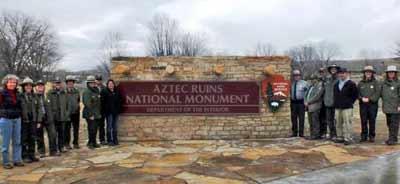The answers to "What do you want for Christmas?" can include some pretty unusual items, but for the staff at Aztec Ruins National Monument their wish was pretty simple: they just wanted an official entrance sign. It's taken nearly 90 years, but their wish has finally come true, and the new sign is unique indeed.
The park was established on January 24, 1923, when President Warren G. Harding issued an executive order creating Aztec Ruins National Monument in Aztec, New Mexico. Over the years the site gradually acquired a visitor center, a short trail and other typical park amenities, but one item was missing—a permanent, official entrance sign.
Filling that need became a team effort for the park staff and the local community. Superintendent Larry Turk began the project, the City of Aztec supported the effort, and all park divisions worked together to make the vision a reality. The goal was "a sign that will welcome visitors and communicate the national significance of the site they are visiting."
On the afternoon of December 13, the park staff gathered for a photo to celebrate the completion of the project, and the result isn't an off-the-shelf, ho-hum sign, but a unique addition that reflects the character of the area.
A park spokesperson offered some details about the sign's unusual construction.
"The sign is built like an ancient wall and incorporates important elements of ancestral Puebloan construction. Stone is shaped and stacked with mud mortar. The wall is the thick core and veneer distinctive of Chaco and Aztec great houses. Large pine beams (vigas) are built into the wall, representing the impressive roofs still surviving in West Ruin."
"For monument employees, the sign provided a lesson in the effort required by ancestral Puebloan builders. Skilled park archaeologists and preservation crew members built the sign in the same way they would repair an ancient wall. From start to finish, the project still took these expert masons four weeks to complete."
"After building up one stone at a time, they pointed mortar into the crevices at the surface for a smooth finish. The tedious work made spectators wonder: How did the ancestral Puebloans build the 450 rooms of West Ruin in only 30 years?"
"The sign project was completed in numerous steps, from the masonry wall, to the wooden vigas, to the metal nameplate, to the surrounding flagstone walkway. The public followed its progress through regular updates on the park’s Facebook page."
A nice gift for the staff, the community and visitors to Aztez Ruins, and a reminder that sometimes making your wish comes true requires a little work…and a lot of patience.




Comments
Yes I'm serious. I can't tell exactly how tall the beams are, but I've heard of plenty of cases where people have been seriously injured by walking into structures that weren't reasonably high. If I were to guess, it's about 6'3" off the ground, and several people in the shot could easily hit the beams.
So - you'd guys would be OK with it if someone is injured while trying to pose for a photo?
I've never seen an NPS sign with anything protruding from the side. Maybe people will be careful, but I could easily imagining someone suing the NPS if they were to be injured. This looks like a unique opportunity for someone to get injured. It's not a natural feature, or a building entrance, or a navy ship (I remember being led on a tour by a 6'6" Chief Petty Officer) where one is likely to take notice It's a sign, and it's easy enough to overlook that it has wooden beams sticking out of the side at head level for some people. The tendency of people walking around a sign for a photo op is to walk across to see where the best angle is that doesn't cover the text of the sign. Someone 6'6" can walk right into that beam on the right. The design of the sign was under the control of NPS employees, and I would have suggested they place the beams higher.
Makes me think of the front door of Hopi House, the Mary Jane Coulter designed and built historic gift shop on the Rim at Grand Canyon. The door frame is so low that even a 6 foot individual must duck their head to get in. Almost a daily occurance for someone to bump their head sometimes significantly. The Rim itself is only a few feet from the front door and without a guardrail around the whole Canyon, is a significantly greater danger. It's just not a safe world out there, Virginia. For those that like to live with the delusion that it is/should be, hope they have a breakthrough and their burden is lifted.
Being 6'4" tall, I can speak with authority when I say that those of us who are taller than "average" are pretty used to watching for things that hang down into our space and miss our shorter brethren and sisters. We occasionally will get a good whack but it's not likely to happen twice in the same day! :)
Great sign!
Hey, the cavemen/women managed to evolve without OSHA or a sue happy mindset. Maybe their attitude/situation could be revived and save the world. We just might be headed in that direction/correction.